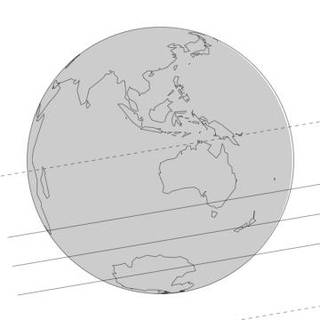Observing Pluto's coverage of a star from an airplane
- Transfer
This material is a free translation of the original article, “SOFIA in the Right Place at the Right Time for Pluto Observations,” published on nasa.gov .
In the early morning hours of June 30, 2015, NASA observed the passage of Pluto in front of a distant star in the New Zealand area. In astronomy, this phenomenon is called coating . For example, in 1977, Uranus rings were discovered during the cover of a star, and the presence of atmosphere in Pluto was discovered long before the New Horizons due to covering the stars with the planet’s disk in 1988, 2002, 2006, and the covering of the star with Charon in 1980 gave an estimate of its radius 585-625 km
When the disk of the dwarf planet appeared exactly in front of the star, the latter created the illumination of Pluto’s atmosphere, and the star’s light shone across the Earth’s surface at a speed of more than 85,000 km / h, which was observed by the NASA team from the Southern hemisphere of the Earth.

In such a case, NASA has an observatory capable of observing coverage directly from the center of Pluto’s shadow, wherever it may be, and at the same time conducting observations above the clouds, this is a specially equipped Boeing 747SP aircraft carrying a telescope with a 2.5-meter aperture.

SOFIA, the Stratospheric Observatory of IR Astronomy, operates at altitudes of 12-14 km in the stratosphere, which makes it possible to come close to the quality of the shooting of space observatories, since the bulk of the water vapor that absorbs the IR spectrum is in the lower atmosphere. SOFIA has three scientific instruments used for observing coverage:
This time, SOFIA flew out of Christchurch, New Zealand, having accurately followed the planned route and made all the necessary measurements.
As a result, very useful measurements were obtained with all three instruments, including a small flash of Pluto at the moment when the star was exactly behind its disk, thus highlighting the whole atmosphere with a light ring.
In this video, Pluto is located to the left and bottom of the center of the frame, a flash of atmospheric illumination at the 5th second.
By the way, SOFIA already observed the Pluto star cover in July 2011, each new observation gives an idea of how the atmosphere of Pluto behaves over the past years. Despite the gradual distance from the Sun, which has been taking place since September 5, 1989, after the passage of perigee, the atmospheric pressure has increased significantly, so in 1988 the estimate was 0.15 Pa, in 2002 it was already 0.3 Pa, and now it is estimated from 0.65 Pa to 2.4 Pa. This is explained by the fact that in 1987, for the first time in 120 years, the north pole of Pluto emerged from the shadows, thus sublimating nitrogen, which was frozen on the surface. After decades, atmospheric nitrogen will settle at the dark south pole.
In the early morning hours of June 30, 2015, NASA observed the passage of Pluto in front of a distant star in the New Zealand area. In astronomy, this phenomenon is called coating . For example, in 1977, Uranus rings were discovered during the cover of a star, and the presence of atmosphere in Pluto was discovered long before the New Horizons due to covering the stars with the planet’s disk in 1988, 2002, 2006, and the covering of the star with Charon in 1980 gave an estimate of its radius 585-625 km
When the disk of the dwarf planet appeared exactly in front of the star, the latter created the illumination of Pluto’s atmosphere, and the star’s light shone across the Earth’s surface at a speed of more than 85,000 km / h, which was observed by the NASA team from the Southern hemisphere of the Earth.

In such a case, NASA has an observatory capable of observing coverage directly from the center of Pluto’s shadow, wherever it may be, and at the same time conducting observations above the clouds, this is a specially equipped Boeing 747SP aircraft carrying a telescope with a 2.5-meter aperture.

SOFIA, the Stratospheric Observatory of IR Astronomy, operates at altitudes of 12-14 km in the stratosphere, which makes it possible to come close to the quality of the shooting of space observatories, since the bulk of the water vapor that absorbs the IR spectrum is in the lower atmosphere. SOFIA has three scientific instruments used for observing coverage:
- HIPO (High-speed Imaging Photometer for Occultations)
- FLITECAM (First Light Infrared TEst CAMera)
- FPI + (Focal Plane Imager-plus)
This time, SOFIA flew out of Christchurch, New Zealand, having accurately followed the planned route and made all the necessary measurements.
As a result, very useful measurements were obtained with all three instruments, including a small flash of Pluto at the moment when the star was exactly behind its disk, thus highlighting the whole atmosphere with a light ring.
In this video, Pluto is located to the left and bottom of the center of the frame, a flash of atmospheric illumination at the 5th second.
By the way, SOFIA already observed the Pluto star cover in July 2011, each new observation gives an idea of how the atmosphere of Pluto behaves over the past years. Despite the gradual distance from the Sun, which has been taking place since September 5, 1989, after the passage of perigee, the atmospheric pressure has increased significantly, so in 1988 the estimate was 0.15 Pa, in 2002 it was already 0.3 Pa, and now it is estimated from 0.65 Pa to 2.4 Pa. This is explained by the fact that in 1987, for the first time in 120 years, the north pole of Pluto emerged from the shadows, thus sublimating nitrogen, which was frozen on the surface. After decades, atmospheric nitrogen will settle at the dark south pole.
